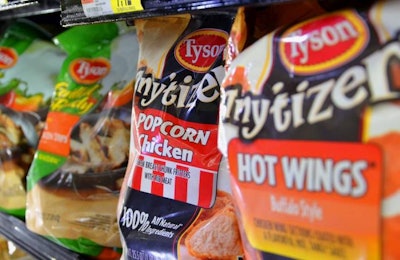
Tyson Foods reported an increase in net earnings for both fiscal year 2017 and the fiscal year’s fourth quarter.
The company announced the financial results for both periods on November 13. Fourth quarter net income attributable to Tyson Foods was up from $391 million in 2016 to $395 million for the fourth quarter of fiscal year 2017. For the full year, net income went from $1.768 billion to $1.774 billion.
“The fourth quarter was a strong finish to another record year,”
Tom Hayes, Tyson Foods’ president and chief executive officer, said. “We delivered well over our goals of at least 4 percent operating income growth, EPS growth in the high single digits and 3 percent volume growth in value-added products, and expect to meet or exceed these goals again in fiscal 2018.
Hayes, in a press release, stated that the company’s Beef and Pork segments delivered outstanding returns for the quarter, which generated money to fuel investments into its Chicken and Prepared Foods segments.
Chicken segment
Sales volume for Tyson Foods’ Chicken segment was up due to better demand for Tyson chicken products along with the incremental volume from the AdvancePierre acquisition. The average sales price increased due to sales mix changes. The segment’s operating income for fiscal 2017 was below prior year record results due to higher operating costs, which included increased compensation and benefit integration expense of $41 million, $17 million of incremental net costs attributable to two plant fires, in addition to restructuring and related charges of $56 million in the fourth quarter of fiscal 2017.
Operating income increased in the fourth quarter of fiscal 2017, despite the $56 million of restructuring and related charges, due to improved operational execution and lower feed ingredient costs, the company reported. Feed costs decreased $65 million and $80 million for the fourth quarter and fiscal 2017, respectively.
Pork segment
Sales volume for the Pork segment increased for fiscal 2017 due to strong demand for the company’s pork products and increased exports.
Sales volume decreased in the fourth quarter of fiscal 2017 as a result of balancing the company’s supply with customer demand. Average sales price increased as demand for pork products and strong exports outpaced the increase in live hog supplies. Operating income increased as Tyson Foods maximized its revenues relative to the live hog markets, partially attributable to stronger export markets and operational and mix performance, which were partially offset by higher operating costs.
Prepared Foods segment
Sales volume for the Prepared Foods segment increased for fiscal 2017 due to improved demand for retail products and incremental volumes from the AdvancePierre acquisition, partially offset by declines in foodservice.
Average sales price increased due to better product mix which was positively impacted by the acquisition of AdvancePierre as well as higher input costs of $50 million for fiscal 2017 and $105 million in the fourth quarter of fiscal 2017. Operating income for fiscal 2017 decreased due to impairments of $52 million related to Tyson Foods’ San Diego operation and of $45 million related to the expected sale of a non-protein business, $30 million of compensation and benefit integration expense, $34 million related to AdvancePierre purchase accounting and acquisition related costs, $82 million of restructuring and related charges, in addition to higher operating costs at some of facilities.
Operating income for the fourth quarter of fiscal 2017 decreased due to an impairment of $45 million related to the expected sale of a non-protein business, $82 million of restructuring and related charges, $14 million related to AdvancePierre purchase accounting and acquisition related costs and higher operating costs at some of Tyson’s facilities.
Additionally, Prepared Foods’ operating income was positively impacted by $137 million in synergies, of which $18 million was incremental synergies in the fourth quarter of fiscal 2017. For the 12 months of fiscal 2017, Prepared Foods operating income was positively impacted by $538 million in synergies, of which $97 million was incremental synergies in fiscal 2017 above the $156 million of synergies realized in fiscal 2016 and $285 million realized in fiscal 2015. The positive impact of these synergies to operating income, the company stated, was partially offset with investments in innovation, new product launches and supporting the growth of Tyson brands.
Beef segment
Sales volume for the Tyson Beef segment increased due to improved availability of cattle supply, stronger domestic demand for the company’s beef products and increased exports. Average sales price increased as demand for beef products and strong exports outpaced the increase in live cattle supplies. Operating income increased due to more favorable market conditions as Tyson maximized its revenues relative to the decline in live fed cattle costs, partially offset by higher operating costs.

















